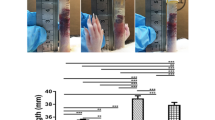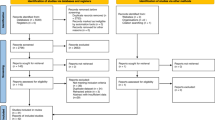Abstract
Treatment options for Peyronie’s disease (PD) remain limited. Topical H100 gel, (Hybrid Medical, Edina, USA), which contains nicardipine, super oxide dismutase and emu oil showed safety and efficacy in a previous small double-blind placebo-controlled pilot study. The present study evaluates if topically applied H100 gel applied to the penile shaft infiltrates the tunica albuginea. Nicardipine is a key active ingredient in H100 and serves as a surrogate marker. Three men already scheduled to undergo a planned surgical procedure for PD applied commercially available H100 gel twice daily to the penile shaft for up to 30 days prior to the procedure. Tunica albuginea samples were obtained at surgery. Nicardipine evaluation was performed using isotope dilution technique via liquid-chromatograph-mass spectrometry (LCMS). All three patients tolerated H100 gel application without side effects. All three tunica albuginea specimens showed detectable nicardipine in the tunical tissue. Transdermal application of commercially available H100 gel is able to penetrate the tunica albuginea tissue and is detectable in men with acute and chronic PD. This finding may support the encouraging results found in the prior H100 pilot study.
Similar content being viewed by others
Introduction
PD is a condition in which scar tissue forms within the tunica albuginea of the corpus cavernosum. It can affect up to 0.5–13% of adult males [1]. Oral agents have shown inconsistent results [2]. Mechanical devices such as traction therapy have some limited utility [3, 4]. Topically applied verapamil has not shown reproducible results and has not been shown to penetrate the tunica albuginea in a tissue study [5]. Intralesional injection of verapamil and nicardipine has shown some benefit in select patients [6, 7]. Specifically, intralesional nicardipine showed improvement in all measured parameters, although curvature changes were also seen with placebo. FDA approved intralesional injected Clostridium histolyticum (Xiaflex, Auxilium Pharmaceuticals, Chesterbrook, PA, USA) has shown some benefit [8].
H100 is a topical gel developed by Hybrid Medical for the treatment of PD. H100 gel contains a proprietary blend of nicardipine, superoxide dismutase and emu oil. A previously published double blind, placebo controlled safety and efficacy pilot study utilizing H100 in patients with PD showed a statistically significant improvement in all measured endpoints, specifically curvature reduction, increased stretched penile length and decreased pain [9]. H100 was well tolerated, with rash as the only reported side effect. While study size was small, results in men with acute phase PD were encouraging.
Because early reports with topically applied verapamil gel also showed PD symptom improvement [10] but subsequent research showed topically applied verapamil gel did not infiltrate tunica albuginea tissue [5], similar questions arose as to the ability of topically applied H100 gel to infiltrate the tunica albuginea tissue.
The present study was modeled after the verapamil penetration study performed and published by Martin et al. [5]. The present study’s sole purpose is to evaluate the ability of topically applied H100 gel to penetrate and infiltrate tunica albuginea tissue.
H100 combines a natural carrier agent, emu oil, with two traditional pharmaceuticals, nicardipine and superoxide dismutase. Emu oil is rich in fatty acids making it an effective transdermal carrier agent [11]. Scar remodeling has also been attributed to emu oil through an unknown mechanism of action [12]. Nicardipine is a dihydropyridine-type calcium channel blocker and has been suggested to be more efficacious in reducing glycosaminoglycan synthesis and blocking collagen production than non-dihydropyridine-type calcium channel blockers, such as verapamil [13]. Superoxide dismutase is a scavenger of oxygen radicals, which are important in the inflammatory process [14].
Materials and methods
The Declaration of Helsinki protocols were followed, and all patients gave their written informed consent. After Institutional Review Board approval, the study was initiated at 2 centers. Inclusion criterion were males with PD planning upcoming surgery with partial plaque excision and grafting. Patients had to be 3 months or longer free from any other PD treatments. Three men with known PD consented to participate. (Table 1).
Study size was intentionally small since the sole end point was to determine the presence or absence of nicardipine tissue penetration after H100 application. All patients agreed to apply topical H100 gel twice daily via metered dose dispenser to the entire penile shaft for a minimum of 16 days prior to surgery.
All 3 patients underwent a partial plaque excision and grafting procedure. All surgeries were uncomplicated, and no intraoperative difficulties were noted. At each procedure, tissue was obtained from the tunica albuginea at the plaque site and stored at −70C. Specimens were transported to an independent lab (Mayo Metabolomics Core, Rochester, MN) for analysis.
No measurements of serum or urine nicardipine levels were performed in this study, since the sole purpose was to evaluate the presence or absence of tissue penetration.
Nicardipine concentration was measured by isotope dilution technique via liquid-chromatograph-mass spectrometry (LCMS) as previously described with a few modifications. Briefly, tissue was made into a homogenate by the addition of 1 X PBS (phosphate-buffered saline) at 10 microlitres/mg prior to adding 10 microlitres of d-3 nicardipine (Santa Cruz chemicals, SC-219353) solution as an internal standard. Protein was precipitated from the sample mixture by adding 2 ml of cold acetonitrile:methanol solution (50:50, v-v). The supernatant was transferred to a 1-dram vial, dried in speed vac without heat prior to resuspension in running buffers for analysis. A 12-point calibration standard curve was constructed using authentic nicardipine standard purchased from Sigma (N7510) and internal standard solution was used in samples. Both standards and samples were analyzed on a Thermo Quantiva triple quadrupole mass spectrometer coupled with a Waters Acquity liquid chromatography system. Data acquisition was done using select ion monitor (SRM), m/z 480 > 315 for nicardipine and m/z 483 > 315 for d-3 nicardipine, via positive electrospray condition [15].
Results
Three patients participated in the study. Mean length of time of H100 application was 25.7 days (range 17–30 days). No adverse side effects were reported with H100 use.
Liquid-chromatograph-mass spectrometry demonstrated Nicardipine levels in all 3 patient samples. Mean tunica sample weight was 33.2 mg (range 48.5 mg to 23.1 mg). Mean nicardipine tissue concentration was 0.171 ng/mg (range 0.051 ng/mg to 0.238 ng/mg) (Table 2).
Discussion
The present study shows that nicardipine, a key ingredient in H100 gel, is found in the tunica albuginea tissue following topical application. Nicardipine is detectable in men with acute and chronic PD (10 months to 8 years). Detectable levels following twice daily 100 application were noted as early as 17 days.
This study is free from bias as participating patients and surgeons were not affiliated with the study sponsor. Study specimens were sent by independent courier for evaluation to an independent metabolomics lab at the Mayo Clinic.
Study weaknesses are noted and understood by the investigators. These include small sample size and the unknown effective therapeutic intra-tunical tissue concentration of nicardipine. Small cohort size also precludes correlation with multiple variables such as PD duration and optimal duration of H100 application with the detectable level of nicardipine in tissue.
While these findings are encouraging, further trials with H100 are indicated to better define its role in treating patients with PD. Attention can be directed at identifying the optimal therapeutic concentration and duration of treatment needed for best results with H100.
Conclusion
In this study of topically applied H100 gel applied to the penile shaft, all three patients tested had detectable levels of nicardipine in the tunica albuginea sampled. The presence of nicardipine in the tunica albuginea supports the rationale for transdermal use of H100 in the treatment of PD. Further study of H100 is recommended.
References
Dibenedetti D, Nguyen D, Zografos L, Ziemiecki R, Zhou X. A population-based study of Peyronie’s disease: prevalence and treatment patterns in the United States. Adv Urol. 2011;2011:282503.
Barrett-Harlow B, Wang R. Oral therapy for Peyronie’s disease, does it work? Transl Androl Urol. 2016;5:296–302.
Ziegelmann M, Savage J, Toussi A, Alom M, Yang D, Kohler T, et al. Outcomes of a novel penile traction device in men with Peyronie’s disease: a randomized, single-blind, controlled trial. J Urol. 2019;202:599–610.
Levine L, Newell M, Taylor F. Penile traction therapy for treatment of Peyronie’s disease: a single-center pilot study. J Sex Med. 2008;5:1468–73.
Martin D, Badwan K, Parker M, Mulhall J. Transdermal application of verapamil gel to the penile shaft fails to infiltrate the tunica albuginea. J Urol. 2002;168:2483–5.
Levine L, Goldman K, Greenfield J. Experience with intraplaque injection of verapamil for Peyronie’s disease. J Urol. 2002;168:621–6.
Soh J, Kawauchi A, Kanemitsu N, Naya Y, Ochial A, Naltoh Y, et al. Nicardipine vs saline injection as treatment for Peyronie’s disease: a prospective, randomized, single-blind study. J Sex Med. 2010;7:3743–9.
Gelbard M, Goldstein I, Hellstrom W, McMahon C, Smith T, Tursi J, et al. Clinical efficacy, safety and tolerability of collagenase clostridium histolyticum for the treatment of Peyronie’s disease in 2 large double-blind, randomized, placebo-controlled phase 3 studies. J Urol. 2013;190:199–207.
Twidwell J, Levine L. Topical treatment for acute phase Peyronie’s disease utilizing a new gel, H-100; a randomized, prospective, placebo-controlled pilot study. Int J Impot Res. 2016;28:41–45.
Fitch W, Easterling W, Talbert R, Bordovsky M, Mosier M. Topical verapamil HCL, topical trifluoperazine, and topical magnesium sulfate for the treatment of Peyronie’s disease- a placebo—controlled pilot study. J Sex Med. 2007;4:477–84.
Zemtsov A, Gaddis M, Montalvo-Lugo V. Moisturizing and cosmetic properties of emu oil: a double-blind study. Aust J Dermatol. 1996;37:159–61.
Qiu X, Wang J, Fang X, Gong Z, Li Z, Yi Z. Anti-inflammatory activity and healing-promoting effects of topical application of emu oil on wound in scaled rats. Di Yi Jun Yi Da Xue Xue Bao. 2005;25:407–10.
Kouoh F, Gressier B, Dine T, Luyckx M, Brunet C, Ballester L, et al. Antioxidant effects and anti-elastase activity of the calcium antagonist nicardipine on activated human and rabbit neutrophils—a potential antiatherosclerotic property of calcium antagonists? Cardiovasc Drugs Ther. 2002;16:515–20.
Kinnula V, Crapo J. Superoxide dismutases in the lung and human lung diseases. Am J Respir Crit Care Med. 2003;167:1600–19.
Yamane N, Takami T, Tozuka Z, Sugiyama Y, Yamazaki A, Kumagai Y. Microdose clinical trial: quantitative determination of nicardipine and prediction of metabolites in human plasma. Drug Metab Pharmacokinet. 2009;24:389–403.
Author information
Authors and Affiliations
Contributions
JT: study design, manuscript creation; JM: patient enrollment; DT: patient enrollment; LL: study design, manuscript review.
Corresponding author
Ethics declarations
Competing interests
JT: Chairman Hybrid Medical, JM: compensated for study patient enrollment by Hybrid Medical, DT: compensated for study patient enrollment by Hybrid Medical, LL: compensated Medical Advisor, Hybrid Medical.
Additional information
Publisher’s note Springer Nature remains neutral with regard to jurisdictional claims in published maps and institutional affiliations.
Rights and permissions
Springer Nature or its licensor (e.g. a society or other partner) holds exclusive rights to this article under a publishing agreement with the author(s) or other rightsholder(s); author self-archiving of the accepted manuscript version of this article is solely governed by the terms of such publishing agreement and applicable law.
About this article
Cite this article
Twidwell, J., Mahon, J., Tortorelis, D. et al. Transdermal application of H100 gel to the penile shaft in patients with Peyronie’s disease infiltrates the tunica albuginea. Int J Impot Res 36, 107–109 (2024). https://doi.org/10.1038/s41443-023-00819-w
Received:
Revised:
Accepted:
Published:
Issue Date:
DOI: https://doi.org/10.1038/s41443-023-00819-w
This article is cited by
-
Unveiling treatment horizons and contemporary perspectives in Peyronie’s disease – take home messages from Laurance A. Levine special issue
International Journal of Impotence Research (2024)



